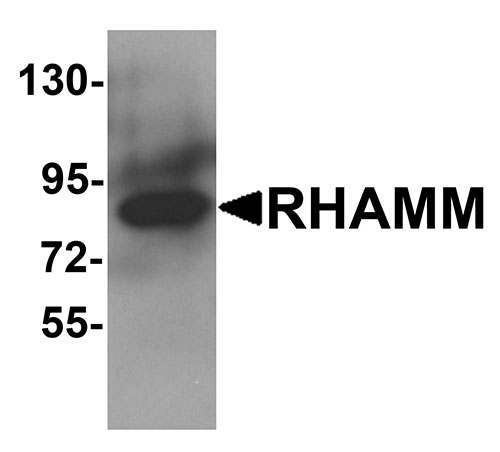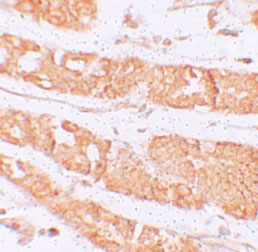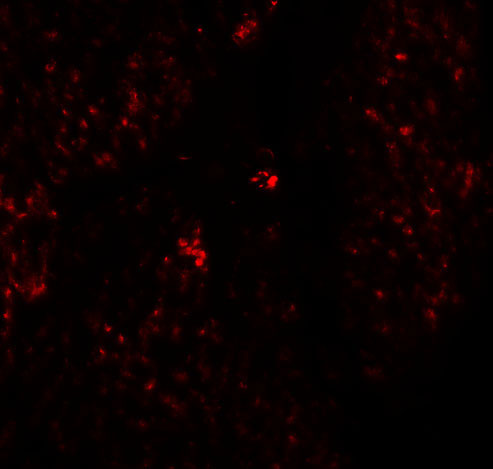RHAMM Antibody
- 产品详情
- 实验流程
- 背景知识
Application
| WB, IF, E, IHC-P |
|---|---|
| Primary Accession | O75330 |
| Other Accession | NP_036617, 217272802 |
| Reactivity | Human, Mouse, Rat |
| Host | Rabbit |
| Clonality | Polyclonal |
| Isotype | IgG |
| Calculated MW | 84100 Da |
| Concentration (mg/ml) | 1 mg/mL |
| Conjugate | Unconjugated |
| Application Notes | RHAMM antibody can be used for detection of RHAMM by Western blot at 1 µg/mL. Antibody can also be used for immunohistochemistry starting at 2.5 µg/mL. For immunofluorescence start at 5 µg/mL. |
| Gene ID | 3161 |
|---|---|
| Other Names | Hyaluronan mediated motility receptor, Intracellular hyaluronic acid-binding protein, Receptor for hyaluronan-mediated motility, CD168, HMMR, IHABP, RHAMM |
| Target/Specificity | HMMR; |
| Reconstitution & Storage | RHAMM antibody can be stored at 4℃ for three months and -20℃, stable for up to one year. As with all antibodies care should be taken to avoid repeated freeze thaw cycles. Antibodies should not be exposed to prolonged high temperatures. |
| Precautions | RHAMM Antibody is for research use only and not for use in diagnostic or therapeutic procedures. |
| Name | HMMR |
|---|---|
| Synonyms | IHABP, RHAMM |
| Function | Receptor for hyaluronic acid (HA) (By similarity). Involved in cell motility (By similarity). When hyaluronan binds to HMMR, the phosphorylation of a number of proteins, including PTK2/FAK1 occurs. May also be involved in cellular transformation and metastasis formation, and in regulating extracellular-regulated kinase (ERK) activity. May act as a regulator of adipogenisis (By similarity). |
| Cellular Location | Cell surface {ECO:0000250|UniProtKB:Q00547}. Cytoplasm. Cytoplasm, cytoskeleton, spindle {ECO:0000250|UniProtKB:Q00547} |
| Tissue Location | Expressed in testis (PubMed:22965910). Expressed in the breast (PubMed:8890751). |
For Research Use Only. Not For Use In Diagnostic Procedures.
Provided below are standard protocols that you may find useful for product applications.
BACKGROUND
RHAMM Antibody: The hyaluronan-mediated motility receptor, also known as RHAMM, was initially identified as a soluble protein that could be released by sub-confluent migrating cells, promoting cell motility and invasion via interactions with hyaluronan (HA) and the cell surface. While RHAMM is normally poorly expressed in most normal tissues and is not required for embryonic development or normal cell homeostasis functions, its expression is increased during wound repair in response to hypoxia and fibrogenic factors. However, its overexpression is transforming in multiple types of cancers and is required for maintaining RAS transformation. RHAMM associates with BRCA1 and BARD1, attenuating the mitotic-spindle-promoting activity of RHAMM, which may contribute to tumor progression by promoting genomic instability.
REFERENCES
Hardwick C, Hoare K, Owens R, et al. Molecular cloning of a novel hyaluronan receptor that promotes tumor cell motility. J. Cell Biol. 1992; 117:1343-50.
Samuel SK, Hurta RA, Spearman MA, et al. TGF-beta 1 stimulation of cell locomotion utilizes the hyaluronan receptor RHAMM and hyaluronan. J. Cell Biol. 1993; 123:749-58.
Hall CL, Yang B, Yang X, et al. Overexpression of the hyaluronan receptor RHAMM is transforming and is also required for H-ras transformation. Cell 1995; 82:19-26.
Maxwell CA, McCarthy J, and Turley E. Cell-surface and mitotic-spindle RHAMM: moonlighting or dual oncogenic functions? J. Cell Sci. 2008; 121:925-32.
终于等到您。ABCEPTA(百远生物)抗体产品。
点击下方“我要评价 ”按钮提交您的反馈信息,您的反馈和评价是我们最宝贵的财富之一,
我们将在1-3个工作日内处理您的反馈信息。
如有疑问,联系:0512-88856768 tech-china@abcepta.com.























 癌症的基本特征包括细胞增殖、血管生成、迁移、凋亡逃避机制和细胞永生等。找到癌症发生过程中这些通路的关键标记物和对应的抗体用于检测至关重要。
癌症的基本特征包括细胞增殖、血管生成、迁移、凋亡逃避机制和细胞永生等。找到癌症发生过程中这些通路的关键标记物和对应的抗体用于检测至关重要。 为您推荐一个泛素化位点预测神器——泛素化分析工具,可以为您的蛋白的泛素化位点作出预测和评分。
为您推荐一个泛素化位点预测神器——泛素化分析工具,可以为您的蛋白的泛素化位点作出预测和评分。 细胞自噬受体图形绘图工具为你的蛋白的细胞受体结合位点作出预测和评分,识别结合到自噬通路中的蛋白是非常重要的,便于让我们理解自噬在正常生理、病理过程中的作用,如发育、细胞分化、神经退化性疾病、压力条件下、感染和癌症。
细胞自噬受体图形绘图工具为你的蛋白的细胞受体结合位点作出预测和评分,识别结合到自噬通路中的蛋白是非常重要的,便于让我们理解自噬在正常生理、病理过程中的作用,如发育、细胞分化、神经退化性疾病、压力条件下、感染和癌症。








